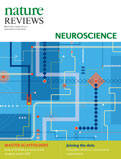|
Advertisement | |||||||||||||||||||||||||||||||||||||
| |||||||||||||||||||||||||||||||||||||
| TABLE OF CONTENTS | |||||||||||||||||||||||||||||||||||||
| March 2017 Volume 18 Number 3 | |||||||||||||||||||||||||||||||||||||
| In this issue
| ||||||||||||||||||||||||||||||||||||
| |||||||||||||||||||||||||||||||||||||
 | |||||||||||||||||||||||||||||||||||||
| Advertisement | |||||||||||||||||||||||||||||||||||||
| |||||||||||||||||||||||||||||||||||||
| |||||||||||||||||||||||||||||||||||||
| REVIEWS | Top | ||||||||||||||||||||||||||||||||||||
| Micro-connectomics: probing the organization of neuronal networks at the cellular scale Manuel Schröter, Ole Paulsen & Edward T. Bullmore p131 | doi:10.1038/nrn.2016.182 Micro-connectomics involves determining the principles of how neuronal networks are organized at the cellular level. In this Review, Schröter, Paulsen and Bullmore examine studies that have provided insight into the network organization of relatively small, as well as more complex, nervous systems. Abstract | Full Text | PDF | |||||||||||||||||||||||||||||||||||||
| SHANK proteins: roles at the synapse and in autism spectrum disorder Patricia Monteiro & Guoping Feng p147 | doi:10.1038/nrn.2016.183 Mutations in the genes encoding the SH3 and multiple ankyrin repeat domains protein (SHANK) family have been linked to autism spectrum disorder, driving a wave of recent studies that aimed to dissect their functional roles in the brain. Monteiro and Feng describe recent findings that have begun to shed light on the important roles of SHANK proteins at the synapse. Abstract | Full Text | PDF | Supplementary information | |||||||||||||||||||||||||||||||||||||
| Fractionating impulsivity: neuropsychiatric implications Jeffrey W. Dalley & Trevor W. Robbins p158 | doi:10.1038/nrn.2017.8 Impulsivity comes in various forms, with some forms considered more or less advantageous than others. Dalley and Robbins review the different types of impulsivity and their underlying neural mechanisms, and comment on the applicability of measures of impulsivity in research into psychiatric disorders. Abstract | Full Text | PDF | |||||||||||||||||||||||||||||||||||||
| PERSPECTIVES | Top | ||||||||||||||||||||||||||||||||||||
| OPINION A distributed, hierarchical and recurrent framework for reward-based choice Laurence T. Hunt & Benjamin Y. Hayden p172 | doi:10.1038/nrn.2017.7 In this Opinion article, Hunt and Hayden highlight that many of the models for reward-based choice are based on distinct component processes that occur in series and are functionally localized. They argue that, instead, such choice emerges from repeated computations that are undertaken in many brain areas. Abstract | Full Text | PDF | |||||||||||||||||||||||||||||||||||||
| OPINION The contribution of the human posterior parietal cortex to episodic memory Carlo Sestieri, Gordon L. Shulman & Maurizio Corbetta p183 | doi:10.1038/nrn.2017.6 Recent human neuroimaging studies suggest that, in addition to its role in visuospatial and sensorimotor processes, the posterior parietal cortex (PPC) also plays an important part in episodic memory retrieval. Here, Sestieri, Shulman and Corbetta present a functional–anatomical model of the involvement of the PPC in memory retrieval. Abstract | Full Text | PDF | |||||||||||||||||||||||||||||||||||||
| |||||||||||||||||||||||||||||||||||||
You have been sent this Table of Contents Alert because you have opted in to receive it. You can change or discontinue your e-mail alerts at any time, by modifying your preferences on your nature.com account at: www.nature.com/myaccount For further technical assistance, please contact our registration department For print subscription enquiries, please contact our subscription department For other enquiries, please contact our feedback department Nature Publishing Group | One New York Plaza, Suite 4500 | New York | NY 10004-1562 | USA Nature Publishing Group's worldwide offices: Macmillan Publishers Limited is a company incorporated in England and Wales under company number 785998 and whose registered office is located at The Campus, 4 Crinan Street, London, N1 9XW. © 2017 Nature Publishing Group, a division of Macmillan Publishers Limited. All Rights Reserved. |
 |









No comments:
Post a Comment